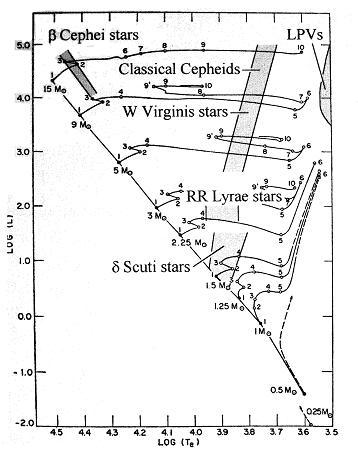
| " " |
|
| Facilities Research Publications Patents Astronomy Software SSC Observatories Contact Us | |
Short Period Variable StarsALL stars do vary.
Sooner, or later, they pulse, blow up, collapse, or simply fade out.
While on any given night the stars seem eternal and unchanging, it just
isn't so. The notion that the heavens vary got Galilleo into much
trouble with the Catholic Church. Now, the idea is a fundamental tenant
of contemporary cosmology.  from: Annual Reveiw Of Astronomy And Astrophysics, 5,571, 1967 Given the enormous size of stars, variations with a period of hours, limits size of the pulses. Pulses propagate through stars as acoustic waves. Kind of like ringing a vary large bell. For very dense objects, these speeds can be very fast. Even so, you should not expect to see large volume changes in a matter of hours. These fundamental limits on the rate at which stars can change volume are the reason that the absolute magnitude of Cephid variable stars, the most famous of the pulsating stars, can be precisely predicted from their periods. Hence, fast pulsating stars have brightness changes that are measured in hundredths to tenths of a magnitude. This level of variations is seldom visible to naked eye observers, but is relatively easy to detect with a CCD or Digital Camera. The diagram above shows the relationship between stellar temperature and luminosity. The temperature of a star determines its color. Its luminosity and distance together determine its apparent brightness. The shaded areas on the chart are luminosity/color regions where stars will pulsate. Higher mass stars appear higher on the chart. The largest family variable of stars with periods of only hours are the Delta Scuti and RR Lyrae variables. The DSCT variables are smaller and hence can pulsate faster. Their range of brightness variation is on the order of 1/10th of a magnitude. The RRLyr stars are more massive and tend to have variations in the range of about 1.0 magnitude. These are suitable targets for visual observers. The other cause of rapid variation in stellar brightness is eclipses. Eclipsing systems consist of two or more stars whose orbital plane is nearly oriented along our line of sight. This results in one of the stars passing in front and in back of its companion as they orbit their mutual center of mass. Such systems can display dramatic effects, particularly if the stars differ significantly in color or volume. For more details on eclisping binary systems see by Eclipsing Binary Stars page Variable Star Observation Observing variable stars is one way in which amateurs can contribute to science. With so many interesting targets, many would go unobserved were it not for the efforts of amateurs. Variable stars can be observed with modest equipment and under most sky conditions, including under light polluted suburban skies. If you have a digital camera, astro-webcam, or CCD camera you have all the gear you need to make precise observations. The easiest method is to point your telescope at the target star and set you camera to make an image every 5 to10 minutes. If you scope tracks reasonably well, just let it go for several hours. When you come back you will have 50 or more images. Using your favorite astro-imaging program measure the brightness of the target star and several companions. You then can use one of the stars as a reference and plot the difference in brightness between your target star and the reference stars. Plot these observations against time and you will soon find you have produced your first light curve. Light curves are important. Their shapes can tell experts about the nature of the variable star. For eclipsing stars, you can determine the relative masses and colors of the stars, the inclination of their orbits, and the eccentricity of their orbits. For pulsating stars you can determine the type of variable, and in some cases the distance to the star. Since these systems are often undergoing rapid evolution, their periods and light curve shapes are evolving. Your observations are important. The best way to share your observations is through the AAVSO (American Association of Variable Star Observers) |
|
|
|||